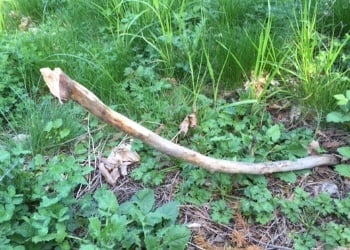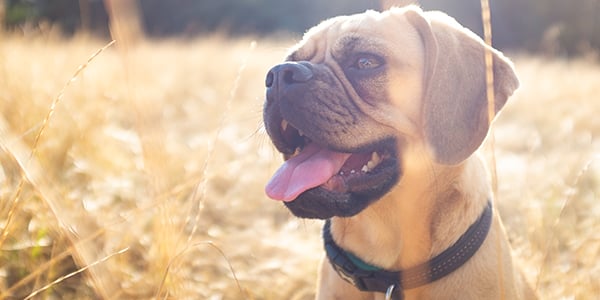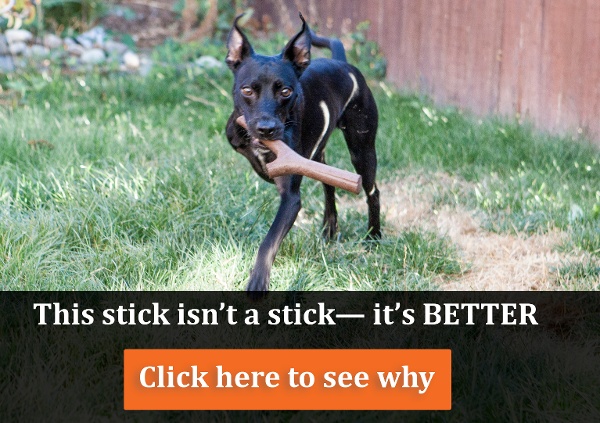
Do you throw sticks for your dog to fetch? Do you let your dog chew on sticks?
Lots of people do, and lots of dogs love to fetch and chew on sticks – "Mother Nature's free toy."
I get nervous (actually very nervous) when I see dogs chewing and chasing sticks. Do you know why?
It’s because many of my veterinary colleagues and I have seen the results of dogs chewing and chasing sticks! And let me tell you, it’s not all fun and games.
Some of the Injuries that Sticks Commonly Cause
- Splinters in a dog's tongue and/or gums
- Punctures of the roof of a dog's mouth, or even their throat
- Tooth fractures or abscesses
- Lacerations in a dog’s mouth
- Splinter-induced infections
- Choking
- Esophageal tears
- Impalement in a dog's eye
- Penetration of a dog's chest, with resulting damage to their heart and/or lungs
- Intestinal perforations and blockages
- Poisoning
Every year, many dogs suffer significant pain and injuries from sticks. While I can’t give you an exact statistic, a report from the UK in 2019 claimed 1.4 million dogs were injured by sticks.
Worse yet, some dogs even die from their stick-related injuries. It’s true – and it happens far more frequently than you might expect. Want some proof? See some stories at the end of this article.
Fortunately, with awareness and some simple preventive steps, you can protect your dog from such a fate. Of course, not every stick-related injury is preventable, so it’s also important that you be aware of the steps you should take in the event that your dog does suffer from one. Read on to learn what you need to know to best protect your dog from the many dangers of sticks.
How Sticks and Tree Branches Injure Dogs
Dogs typically sustain stick-related injuries in one of two ways – through chasing or chewing. And while stick-chasing injuries are typically more severe than the stick-chewing injuries, that’s not always the case.
Sticks, abundant and free though they may be, truly can pose significant, costly, and life-threatening injuries to your dog.
Stick chewers are at risk of a multitude of problems, ranging from wood splinters stuck under their gums and other tissues in the mouth to obstruction of their digestive and/or respiratory tract with wood.
Common Stick Chewing Injuries
Splinters:
Small but painful and otherwise problematic wood splinters can become embedded in the tongue and laryngeal tissues (the larynx is at the back of the throat), or under the gumline next to the teeth.Among other functions, the larynx helps to control what does and does not pass into the trachea (windpipe) and esophagus (food pipe), and, therefore, into the respiratory and digestive tracts, respectively.
Wood fragments:
Large wood fragments can become embedded between the upper teeth and along the surface of the hard palate, or even embedded directly into the hard palate. This can result in severe enough damage to the teeth or palate to require surgery, which is costly in many ways.Swallowed wood fragments:
Large wood fragments that are swallowed can cause digestive tract irritation, bleeding, and possible obstruction or perforation.Inhaled wood fragments:
Large or small pieces of wood can be aspirated into the trachea, leading to possible obstruction, irritation, and/or infection of the respiratory tract. Such wood fragments can also lead to puncture of the trachea or lung tissue, resulting in a chest infection or even damage to the heart, nerves, and/or blood vessels.
Toxicity:
Besides the physical injuries chewing on sticks can cause, there is the risk of poisoning. There are certain woods that are toxic to dogs. Wood that is poisonous to dogs include:Black walnut
- Digestive upset
- Musculoskeletal signs
- Neurological signs
Cherry
- Abdominal pain
- Difficulty breathing
- Dilated pupils
- Digestive upset, such as vomiting and diarrhea
- Drooling
- Weakness
- Digestive upset, such as diarrhea and vomiting
- Neurological signs such as depression or excitement, dilated pupils, unsteadiness, weakness, seizures, or coma
- Digestive upset, such as vomiting and diarrhea
- Increased thirst and dehydration
- Agitation or shaking
- Rapid breathing
- Sleepiness
- Weakness
- Foaming at the mouth
- Convulsions
- Coma
- Unevenly dilated pupils
- Abdominal pain
- Depression
- Diarrhea
- Death
- Diarrhea
- Drooling
- lethargy
- Loss of appetite
- Vomiting
- Liver issues
- Continual consumption has been linked to cancer
- Difficulty breathing
- Muscle tremors
- Seizures
- Sudden death from acute heart failure
NOTE: Contact the Pet Poison Helpline (855-764-7661) or the ASPCA Poison Control (888-426-4435) if you are unsure if the stick your dog has been chewing on is poisonous or not. Fees may apply when calling these poison control centers.
Common Injuries When Playing Fetch with Sticks
These injuries typically happen when a thrown stick gets stuck in the ground, and the eager dog either pounces or runs onto the exposed, sharp end of it. These sticks then cause significant puncture wounds and other damage.
Eye: Resulting in direct damage to their eye, including the blood vessels and nerves associated with the eye. If the force of the penetration is great enough, the stick can result in damage to your dog’s brain, too.Mouth: Stick penetration in the mouth can wreak havoc with a lot of important structures, including the tongue, laryngeal and pharyngeal tissues, palate (“roof”) of the mouth, teeth, esophagus, and trachea. These types of traumas can also cause damage to the nerves and/or blood vessels within your dog’s neck, and, depending on the direction the stick takes, there can also be significant damage to your dog’s sinuses and/or brain.
Chest: As you might imagine, with all of the important structures that are present within the chest cavity, the damage that a stick penetration in this area can be severe.
Along with the heart and lungs, the chest also houses many large blood vessels and important nerves, as well as the diaphragm, trachea, and esophagus. If the penetrating stick enters their chest in the area of their armpit (axilla), then you can also have damage to their brachial plexus – an important grouping of nerves and blood vessels.
Abdomen: Stick penetration in this area can easily result in damage to multiple important organs. Commonly affected organs include the stomach, liver, spleen, and intestines. Additional damage to the urinary bladder, gall bladder, and/or diaphragm often further complicates the surgery that is necessary to save the life of these dogs.
To make matters worse, the initial damage caused by the penetration of the stick isn’t always indicative of the full extent of a dog’s injuries, either.
Despite best efforts, it’s often possible for small fragments or splinters of wood to be missed during initial surgical exploration of puncture wounds. This is not due to a lack of care or skill on the part of the attending veterinary team, but rather due to the nature of penetrating stick foreign bodies, which shatter and splinter upon impact.
This potential problem is compounded by the fact that wood itself doesn’t necessarily show up on X-rays, especially small splinters of wood. So, there is always the possibility of the need for further surgeries once the situation has become clearer and any residual wood pieces have “declared” themselves.

What You Should Do if Your Dog Runs Onto a Stick
The steps you should take can vary slightly with the area of penetration, the number of helpers you have, and your distance from the nearest Animal ER. However, there are some steps that are important regardless of these influencing factors.
What to Do in Cases of Stick Impalement
- Get your dog in for veterinary evaluation and treatment immediately.
Delay doesn’t just prolong pain, suffering, and distress; it’s likely to increase your dog’s risk of death, too. If possible, call the hospital while en route to advise them of your impending arrival – doing so can allow the medical team to be better prepared to more quickly care for your dog when you get there. - Muzzle your dog to prevent anyone from getting bitten. They are scared, anxious, and painful, and may bite.
- Avoid the urge to remove the stick. It’s typically better to leave the penetrating stick in place, so that it can be removed and its path evaluated once at the vet. Sometimes the mere presence of the stick is the only thing preventing a massive loss of blood and/or a collapsed lung. Your default action should be to leave the stick in place, if possible and safe to do so.
- Prevent the protruding end of the stick from getting caught on anything during transport to the vet.
Try not to snap or saw the stick, as the jarring motion that can result from doing so can dislodge the stick or even cause further damage. If you can safely cut the protruding end of the stick, without causing too much vibration or movement, and if doing so won’t unnecessarily delay your arrival at the vet hospital, this can be attempted. - Control bleeding by applying direct pressure AROUND the stick, not on it, with a clean cloth, towel, or bandage.
- Wrap the protruding end of the stick with a t-shirt, towel, bandage material, or some other bulky material.
This won’t only prevent the sharp end of the stick from injuring you or whoever else is carrying your dog, but it can also help prevent the stick from migrating further into your dog and causing more internal damage. - If the stick has penetrated their chest, you should try, if at all possible, to keep your dog lying upright, on the bottom part of his chest and his belly, rather than on their side, during the drive to the vet. This will help by allowing the unaffected side of the lungs to work as efficiently as possible to compensate for the damage that is likely to have occurred to the lungs on the side of the stick penetration. It’ll help your dog breathe better.

True Stories of the Dangers of Sticks for Dogs
One of my FAVORITE patients, Sam, was a wonderful, easy-going Labrador that just seemed to never have luck on his side. His owners brought him in for an examination because he wasn’t eating normally, and they noticed he had bad breath. Fortunately, he allowed me to open his mouth wide, and I found a stick wedged between his fourth upper premolars. The stick caused damage to the roof of his mouth and the gum and bone surrounding the teeth. Following surgical removal of both teeth and medications, he made a full recovery.
While the last story had a happy, yet costly ending, this one doesn’t. I had the sweetest, young Labrador patient who LOVED to play with and chew on sticks. Sadly, one day, a family member went out to care for the dog, and she was dead. We had just seen this happy and playful pup within the week. We examined her to try to determine why she may have died. What we found was that a piece of a stick had perforated her intestines, and she died of peritonitis.
Story of a dog with a punctured lung and a broken rib.
Another dog who almost died from fetching a stick and suffering a mouth injury.
There are many other stories online, so believe me, I am not trying to scare you (well, maybe a little) or force you to buy safe chew and fetch toys. I just want to make you fully aware of the potential dangers to your dog if they play with sticks, because it is my job to inform and educate you. While nothing may ever happen, if it does, the guilt you will feel is not worth it.




